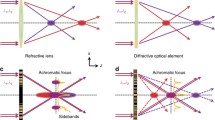Conclusions
The quartz resonators described above can be used for investigating certain physical phenomena. Their main advantage consists in their translucence under oscillatory conditions to light, x-ray, and other radiations. For instance, by transmitting light rays through an oscillating quartz crystal it is possible to observe their diffraction on an ultrasonic grid, and by transmitting through that crystal x-rays it is possible to observe the relaxation of microstresses in a crystal lattice after the application of the exciting force is stopped. It would appear that this method may prove useful in investigating problems related to the pressure of light, and the excitation of quartz crystals by an UHF power transmitted through them. The possibility of making highly-sensitive detectors and instruments on this basis is not excluded.
Similar content being viewed by others
Literature cited
A. G. Smagin, Transactions of the VNIIFTRI (All-Union Scientific Research Institute of Physicotechnical and Radiotechnical Measurements), 1958, collection 2.
I. V. Atanasoff and P. I. Hart, Phys. Rev. 59 (1941).
R. Bechmann, Archiv der elektrischen Übertragung, 7, No. 7 (1953).
W. Janouschewsky, Annales Fran. de Chronometrie (1960).
A. G. Smagin, Kristallografiya (Crystallography), Vol. 4, No. 6 (1959).
A. G. Smagin, DAN (SSSR), Vol. 118, No. 6 (1958).
A. G. Smagin, Izmeritel'naya Tekhnika, No. 9 (1960).
Rights and permissions
About this article
Cite this article
Smagin, A.G., Vysokosov, E.P. Excitation of quartz lenses with clearances in a parallel field. Meas Tech 6, 260–262 (1963). https://doi.org/10.1007/BF01409271
Issue Date:
DOI: https://doi.org/10.1007/BF01409271




